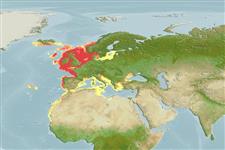Common names from other countries
>
Callionymiformes (Dragonets) >
Callionymidae (Dragonets)
Etymology: Callionymus: Greek, kallion, comparative of kallos = beautiful + Greek, onyma = name; with a better name .
More on author: Linnaeus.
Environment: milieu / climate zone / depth range / distribution range
Ekologi
laut dasar (demersal); kisaran kedalaman 1 - 440 m (Ref. 5968), usually 5 - 30 m (Ref. 27115). Temperate; 16°C - 20°C (Ref. 27115); 66°N - 16°N, 42°W - 42°E
Eastern Atlantic: southern Iceland and Norway south to Mauritania, including the northern Mediterranean, Gibraltar, and Algeria, western Black Sea, Aegean and Adriatic Sea, Azores and the Canary Islands.
Length at first maturity / Size / Weight / umur
Maturity: Lm 17.4 range ? - ? cm
Max length : 30.5 cm TL jantan/; (Ref. 59122); 25.0 cm TL (female); common length : 15.0 cm TL jantan/; (Ref. 3397); Umur maksimum dilaporkan: 7 Tahun (Ref. 72462)
Duri punggung (Keseluruhan (total)) : 4; duri punggung lunak (Keseluruhan (total)) : 8 - 10; Sirip dubur lunak: 9. Gill opening dorsal. Usually antrorse (forward-pointing) tip at base of preopercular spine. Rays of second dorsal unbranched except for the last, which is divided at base (Ref. 232). Snout length 2-3 times the diameter of the eye (Ref. 35388).
Occurs on sand and muddy bottoms from sublittoral to 200 m (Ref. 6444) and to 400 m or more (Ref. 9900). Feeds on small invertebrates, mainly worms and crustaceans. Territorial, males aggressive with each other. Complex courtship behavior consists of 4 phases: courtship, pairing, ascending, releasing eggs and milt. Pelagic eggs and larvae (Ref. 5968). Minimum depth reported from Ref. 27115. Neither opercular spine gland nor anterolateral glandular groove with venom gland is present (Ref. 57406).
Complex courtship behavior with 4 phases: courtship, pairing, ascending, releasing eggs and milt (Ref. 5968).
Davis, W.P and R. Fricke, 1990. Callionymidae. p. 921-924. In J.C. Quero, J.C. Hureau, C. Karrer, A. Post and L. Saldanha (eds.) Check-list of the fishes of the eastern tropical Atlantic (CLOFETA). JNICT, Lisbon, SEI, Paris; and UNESCO, Paris. Vol. 2. (Ref. 6941)
Status IUCN Red List (Ref. 130435)
CITES (Ref. 128078)
Not Evaluated
penggunaan manusia
Perikanan: nilai komersial kecil; Akuarium: Akuarium publik
Alat, peralatan
laporan khas
muat turun XML
Sumber internet
Estimates based on models
Preferred temperature (Ref.
115969): 11.7 - 19.5, mean 13.3 (based on 92 cells).
Phylogenetic diversity index (Ref.
82804): PD
50 = 0.5000 [Uniqueness, from 0.5 = low to 2.0 = high].
Bayesian length-weight: a=0.01096 (0.00905 - 0.01329), b=2.76 (2.71 - 2.81), in cm Total Length, based on LWR estimates for this species (Ref.
93245).
Trophic level (Ref.
69278): 3.3 ±0.38 se; based on food items.
Daya lenting (Ref.
120179): sedang, Waktu penggandaan populasi minimum 1.4 - 4.4 tahun (K=0.43-0.47; tmax=6).
Fishing Vulnerability (Ref.
59153): Low to moderate vulnerability (29 of 100).
